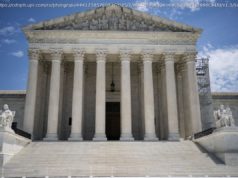Maria’s winds ripped through the only tropical rain forest in the United States forest system, decimating much of its flora and fauna.
LUQUILLO, P. R. — When you looked up, you could once see nothing but the lush, emerald canopy of tabonuco and sierra palm trees covering El Yunque National Forest .
That was before Hurricane Maria obliterated the only tropical rain forest in the United States forest system. Left behind was a scene so bare that on a recent visit, it was possible to see the concrete skyline of San Juan about 30 miles west — a previously unimaginable sight.
El Yunque, pronounced Jun-kay, has been an enormous source of pride in Puerto Rico and one of the main drivers of the island’s tourism industry. The 28,000-acre forest on the eastern part of the island has over 240 species of trees; 23 of those are found nowhere else. Over 50 bird species live among the forest’s crags and waterfalls.
But sunlight now reaches cavities of the forest that have not felt a ray of light in decades, bringing with it a scorching heat.
“Hurricane Maria was like a shock to the system,” said Grizelle González, a project leader at the International Institute of Tropical Forestry, part of United States Department of Agriculture. “The whole forest is completely defoliated.”
The hardest hit areas at the top of the forest “might take a century to recover,” Ms. González, who has worked at El Yunque for 17 years, said.
Tree trunks that still stood were left brown, stripped of their leaves and dark-green mosses. Landslides have scattered the forest with mounds of displaced soil and boulders.
The billions of gallons of water that rain every year on the eight major rivers that originate here supply 20 percent of the drinkable water in Puerto Rico.
“What’s going to happen if the ecosystem has less capacity to capture that water, get it into the streams, and into the municipal water systems?” Sharon Wallace, the forest supervisor for El Yunque, said.
Bryophytes, mosses that grow on tree trunks, collect a lot of the water that goes down the mountain, Ms. Gónzalez said. But trees were stripped of the mosses, especially on the face that received the direct fury of Maria’s winds.
The bird population also suffered a devastating hit. Birds are typically affected after hurricanes ravage trees of the food they eat. But on an initial scouting trip to the accessible parts of the forest, Ms. Gónzalez said she saw the bodies of dozens of blackbirds and pearly-eyed thrashers that had died because of the hurricane’s galloping gusts.
The livelihood of the Puerto Rican parrot, an endangered species living in El Yunque and Río Abajo State Forest, is of special concern. The colorful bright-green bird with a distinctive red stripe above its beak is found only in Puerto Rico and is the only native parrot species in the United States.
“The Puerto Rican parrot is an iconic species of the island,” Marisel López, leader of the The Puerto Rican Parrot Recovery Program, of the United States Fish and Wildlife Service, said. “It’s our legacy.”
While there were tens of thousands in pre-Columbian times, the parrot population dwindled to 13 by 1973 because of deforestation, hunting and species competition. Conservation efforts since then have helped rebuild the population, and before Maria, the captive and wild population combined numbered over 500, Ms. López said. At least seven parrots died in captivity because of the stress induced by the hurricane and the high heat in the days after because of the lack of canopy, she said.
Ms. López, whose team is trying to gain access to the western part of El Yunque where the parrots live, said the toll in the wild population was not known.
The tourism industry in Puerto Rico is deeply intertwined with its environment.
About 1.2 million people visit El Yunque every year for its hiking trails, zip-lining, camping and waterfalls. But the rain forest has remained closed since Maria left roads inaccessible and all its recreational facilities received blows, Ms. Wallace, the forest supervisor, said.
“We don’t know how long it is going to take to reopen,” she said.
And on an island, where 58 percent of the acreage is forests, Maria’s ecological damage was widespread.
The population of mountain coquí, one of the 14 species of a small native frog, with a distinctive mating call heard at night across the island, was severely decimated by Hurricane Hugo in 1989, Rafael Joglar, a professor of biology at the University of Puerto Rico, said.
Hurricane Maria could be the final straw for that species, Mr. Joglar said.
“It worries us that it’ll be the next species to disappear in Puerto Rico,” Mr. Joglar, a herpetologist, said. “The worst would be if we get a dry season — that would be the mortal blow other than the hurricane.”
Over a million bats, encompassing 13 different species, call Puerto Rico their home, Allen Kurta, a professor of biology at Eastern Michigan University, said.
A majority of the bats in Puerto Rico live in caves and probably weathered the storm better than those that roost in trees, he said.
Beside direct mortality from hurricane winds, bat and bird populations will be faced with the daunting task of finding new tree habitats and scavenging for food.
“Nectar feeders and fruit eaters are going to have a very hard time because all the major fruit and nectar trees are down,” said Mr. Kurta, who has studied bats for 40 years.
As bat populations recover, they will play a crucial role in pollinating and dispersing seeds that will help Puerto Rican forests recover.
Some experts say the island’s environment will recover and eventually flourish.
Hurricanes are part of Puerto Rico, natural cleansers of the tropical ecosystem, scientists say. Nature’s mechanisms will kick in, they say, and spark the forest’s natural recuperation just as they did after Hurricane San Ciprian in 1932 and Hurricane Hugo in 1989.
“Obviously there’s a negative immediate effect,” a wildlife biologist, Jafet Vélez, said. “But we know by experience that, long-term, this will cause a rejuvenation in the vegetation of the forest that will benefit all the species that reside there.”
New sun exposure will spark a rebirth of latent plant species in the forest’s thicket that once stopped growing because of dense canopies that blocked sunlight, Mr.
Start
United States
USA — Political Another Victim of Hurricane Maria: Puerto Rico’s Treasured Rainforest






